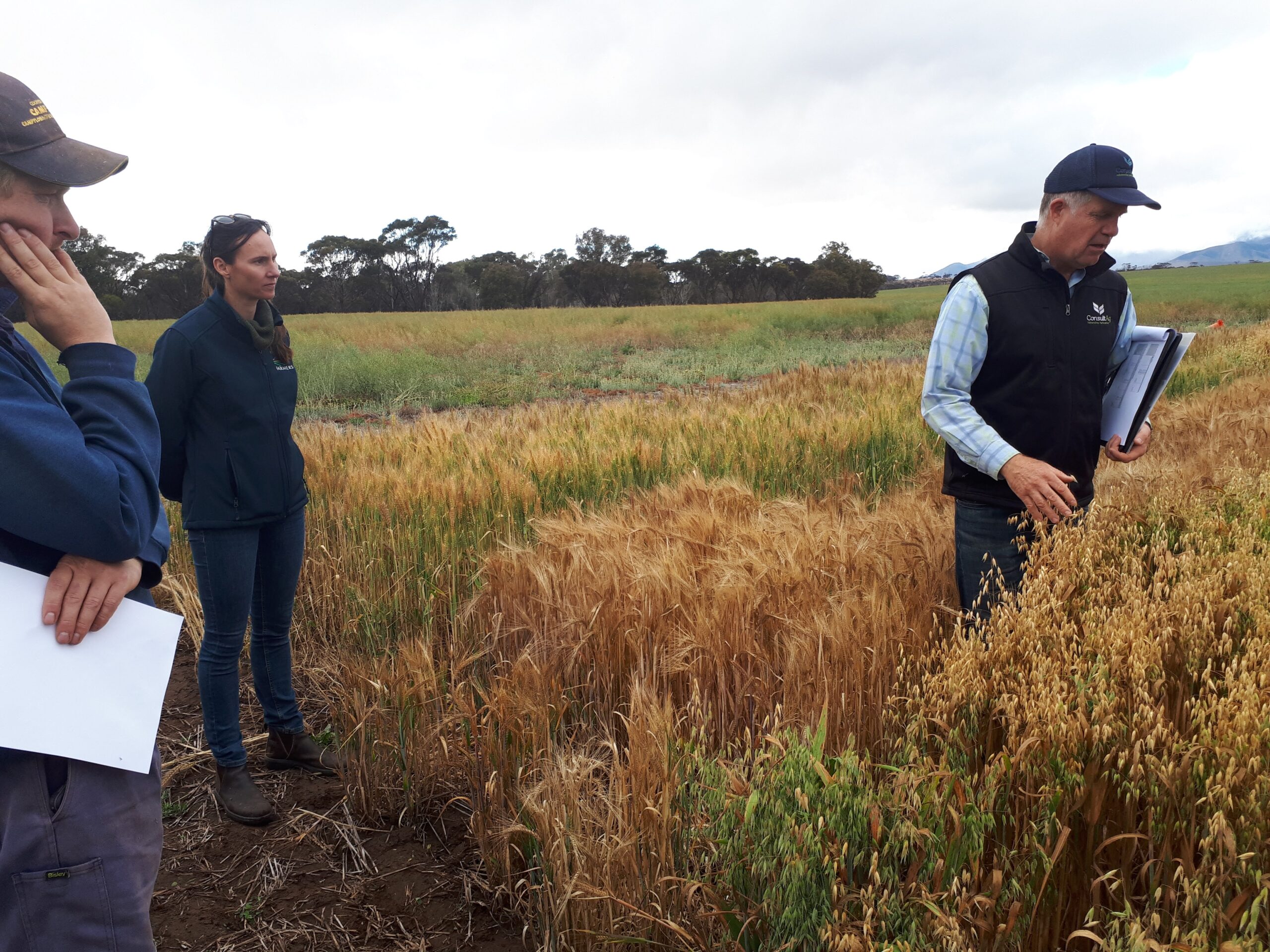Frost, now and in the future
How does time of sowing and crop type help mitigate the impact of frost in Southern WA?
Early this month growers and advisors were invited by Stirlings to Coast Farmers to attend its Pop-up Frost Field Day at the site. As part of the GGA’s, GRDC’s, and Stirlings to Coast Farmers’ trial, intentionally established in frost prone areas, the impact of 21 separate frost events was observed.

ConsultAg Agronomist Garren Knell showing participants what to look for when identifying frost
Frost observations and early results
The Grower Group Alliance (GGA), Grains Research Development Corporation (GRDC) and Stirlings to Coast Farmers’ trial site has endured 21 separate frost events this season.
At the Amelup trial site, wheat (Scepter, Rockstar, Denison), barley (Planet, Rosalind), canola (Trident) oats (Bannister) and lupins (Jurien) were purposely sown in this frost prone region of the North Stirlings. The aim of the trial was to demonstrate how frost impact differed among various crop types and sowing times.
The first (TOS1) was sown early on April 28, the second (TOS2) late on June 6.
On Novemeber 2 growers and advisors were invited by Stirlings to Coast Farmers to attend its Pop-up Frost Field Day at the site. Of the 21 frost events, the most severe occurred prior to flowering on June 31, and was therefore of little consequence to crop yield in either trial. However, the less severe September 23/24 frost events fell mid-flowering for TOS1 and had a negative impact on crop yield.
Preliminary observations found that for this region, late April is too early and early June too late for the wheat varieties used. The early sown Scepter and Rockstar wheat were badly frosted with up to 50% missing grain. Whilst the Denison (the slowest spring wheat) was estimated to be missing about 25%. The early sown barley was similarly impacted, with both varieties estimated to have lost a quarter of their grain due to frost.
The early time of sowing was a clear demonstration that peak flowering aligns with the frost window in this region, but a later time of sowing can help avoid much of this frost risk during flowering.
ConsultAg Agronomist Garren Knell was on-site to share his frost expertise at the Pop-up Field Day and said the trial sites had demonstrated more than just the impact of time of sowing on frost severity across various crop types.
“[The findings also demonstrated that] barley is considered more tolerant to flower frost than wheat, but can get grain damage from late events,” Mr Knell said.
“This is partly because barley usually flowers in the boot and it is better at redistributing energy to unaffected grains which compensates for the loss in grain number and the longer season varieties often have a longer flowering window which can mitigate frost risk”, he said.
When it came to canola frost management is more about paddock selection than time of sowing. He urged growers to go early and chase yield.
“Brassicas like the cold and have a long flowering window allowing compensation of lost flowers due to early frost.”
“Canola is generally more susceptible to late frost events during grain fill, which will have an impact no matter what the sowing date, and there is no time to compensate” he said.
Mr Knell also mentioned crop varieties that were less susceptible to frost.
“Oats are considered the lowest risk cereal for frost prone paddocks and are more tolerant than wheat or barley,” he said
Reminding growers that oats are a useful option where you have good market access and noted a potential upswing for markets with the growing interest in oats as a health food and interest in oat milk.
Mr Knell also made a case for legumes.
“Lupins can be quite tolerant of frost, and if they are damaged, they are a cheaper crop to grow and you still gain the rotational benefit.”
“In some instances, I’ve seen pods frozen on the outside and the grains seemingly unaffected.”
“[As for] faba beans they are susceptible to frost but the beans are spread through the canopy which reduces the risk of frost impacting total yield.”
Some parting advice for growers in highly prone frost regions was to think about pastures. For instance, productivity is maximised in this frost prone paddock with a rotation of clover, canola and barley.
For more information contact Stirlings to Coast Farmers (08) 9842 6653 or Garren Knell at ConsultAg 0427 442 887
